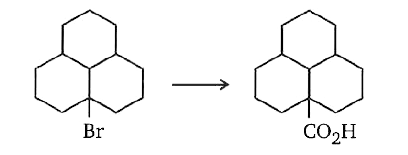Mg3B2aq.HCl−−−−→x↓H2Oy+H2+MgCl2
for (X) and (Y) the incorrect choice is?
(X) is BCl3
(Y) is H3BO3
(X) with air and (Y) on strong heating (red heat) give same compound
In (Y) boron completes is octet by moving H+ from water molecule
The correct Answer is:A
To solve the question regarding the reaction of Mg3B2 with aqueous HCl and the subsequent reactions, we will follow these steps:
Step 1: Identify the Reaction of Mg3B2 with Aqueous HCl
The first step is to write the balanced chemical equation for the reaction of magnesium diboride (Mg3B2) with hydrochloric acid (HCl). The products of this reaction are diborane (B2H6) and magnesium chloride (MgCl2).
The balanced equation is:
Mg3B2+6HCl→B2H6+3MgCl2
Step 2: Identify Product X
From the balanced equation, we can see that product X is diborane (B2H6).
Step 3: Reaction of X with Water
Next, we need to determine what happens when X (diborane) reacts with water. The reaction of diborane with water produces boric acid (H3BO3) and hydrogen gas (H2).
The balanced equation for this reaction is:
B2H6+6H2O→2H3BO3+3H2
Step 4: Identify Product Y
From this reaction, we can conclude that product Y is boric acid (H3BO3).
Step 5: Evaluate the Given Options
Now, we need to evaluate the given options to identify which one is incorrect regarding X and Y.
1. Option A: X is BCl3 - Incorrect (since X is B2H6).
2. Option B: Y is H3BO3 - Correct (since Y is indeed boric acid).
3. Option C: X with air and Y on strong heating gives the same compound - Correct (both yield B2O3).
4. Option D: In Y, boron completes its octet by moving H+ from the water molecule - Correct (this describes the reaction mechanism accurately).
Conclusion
Thus, the incorrect choice regarding products X and Y is Option A.
---
Mg3B2+6HCl→B2H6+3MgCl2
B2H6+6H2O→2H3BO3+3H2
2. Option B: Y is H3BO3 - Correct (since Y is indeed boric acid).
3. Option C: X with air and Y on strong heating gives the same compound - Correct (both yield B2O3).
4. Option D: In Y, boron completes its octet by moving H+ from the water molecule - Correct (this describes the reaction mechanism accurately).
Similar Questions
Knowledge Check
Compare the two methods shown for the preparation of carboxylic acids:

Mehod 1 : RBrMg−−−−−−→diethyl etherRMgBr1.CO2−−−−→2.H3O+RCO2H
Method 2 : RBrNaCN−−−→RCNH2O,HCl−−−−−→heatRCO2H
Which one of the following statements correctly describes this conversion ?
 ABoth method 1 and method 2 are appropriate for carrying out this conversionBNeither method 1 nor method 2 is appropriate for carrying out this conversionCMethod 1 will workwell, but method 2 is not appropriateDMethod 2 will workwell, but method 1 is not appropriate
ABoth method 1 and method 2 are appropriate for carrying out this conversionBNeither method 1 nor method 2 is appropriate for carrying out this conversionCMethod 1 will workwell, but method 2 is not appropriateDMethod 2 will workwell, but method 1 is not appropriateConsider the following reaction sequence ,
CH3CH(OH)CH3ConcH2SO4−−−−−−−−→HeatXdil.H2SO4−−−−−−−−→H2OY
X and Y in the reaction respectively areACH3CH=CH2,CH3CH(OH)CH3BCH3CH=CHCH3,CH3CH2CH2OHCCH3CH2CH=CH2,CH3,CH2CH2OHDCH3CH2CH2CH3,CH3CH(OH)CH2CH3
CH3CH2COOHCl2/Fe−−−−→(X)Alc.−−→KOH(Y)
Compound (Y) is :
View Solution(CH3)2CONaCN−−−→HCI(A)H+3O−−→Δ(B)
In the above sequence of reactions, (A) and (B) are :
View SolutionIn the sequence of reactions
C6H5BrMg−−→ether(X)(i)CO2−−−−−−→(iii)H3O+(Y) the product (Y) is
View SolutionC6H10NBS−−→(X)Mgether−−−−→(Y)CH3CN−−−−→H3O+(Z)
The compound (Z) is
View SolutionCH3COOHBr2/P−−−→(Y)(i)KCN−−−−−−→(ii)H3O+(X)
Here, (X) is :
View SolutionIn the following reaction sequence
Ph−C≡CHaq.H2SO4−−−−−→Hg2+A1.CH3MgI−−−−−−→2.H2OB
the product (B) is
View Solution

 (A) overset(NaNO_(2)//HCl)underset((ii)H_(2)//Ni)underset(0-5^(@))(rarr)(B) , is:
(A) overset(NaNO_(2)//HCl)underset((ii)H_(2)//Ni)underset(0-5^(@))(rarr)(B) , is: